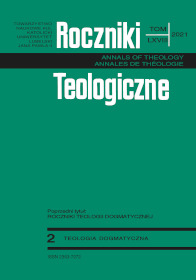A Fifth Mark of the Church?
Abstract
In addition to the four marks of the Church, mercy has been emphasized since the pontificate of St. John Paul II as essential to the authentic fulfillment of the Church’s identity and mission. A Christological and pneumatological understanding of these marks of the Church leads to a proper grasp of the Church in relation to mercy. The Church is merciful not de facto because of her works of mercy on behalf of the poor or sinners. Rather, she is first the recipient of unprecedented Divine Mercy, poured forth in the gift of the Holy Spirit, and so shares that same Spirit of Mercy with others through her sacraments, preaching, and service. The Church’s mission of mercy thus extends beyond the myriad of manners to alleviate human misery. In union with Christ, her Bridegroom, the Church is to communicate the one gift of Divine Mercy, the Holy Spirit, to all.
References
Augustine. “Sermones” 267, 4. In Patrologia Latina, edited by Jaques-Paul Migne, 38-9, 1231D. Paris: J.-P. Migne, 1844-1864.
Augustine. “The Confessions.” New Advent. Accessed January 22, 2021. https://www.newadvent.org/fathers/1101.htm.
Balthasar, Hans Urs von. Theo-logic: Theological Logical Theory. Translated by Adrian J. Walker, and Graham Harrison. San Francisco: Ignatius Press, 2000-2005.
Barron, Robert. “The Metaphysics of Coinherence.” In Barron, Robert. Exploring Catholic Theology: Essays on God, Liturgy and Evangelization. Grand Rapids: Baker Academic, 2015.
Benedict XVI. Encyclical Deus Caritas est. Vatican: Libreria Editrice Vaticana, 2005.
Cantalamessa, Raniero. Gaze of Mercy: A Commentary on Divine and Human Mercy. Frederick, MD: The Word Among Us Press, 2015.
Catechism of the Catholic Church. United States Catholic Conference, 1997.
Emery. Giles. Teologia trynitarna Świętego Tomasza z Akwinu. Kraków: Dominikańska Biblioteka Teologii, 2014.
Francis. Apostolic Letter Misericordiae vultus. Vatican: Libreria Editrice Vaticana, 2015.
Giussani, Luigi. La liberta di Dio. Milan: Marietti, 2005.
Giussani, Luigi, Stefano Alberto, and Javier Prades. Generare tracce nella storia del mondo: Nuove tracce d’esperienza cristana. 3rd ed. Milan: Rizzoli, 1998.
Gręś, Stanisław. Misja Ducha Świętego w prowadzeniu Kościoła do Paruzji Chrystusa. Studium pneumatologiczno-mariologiczne. Niepokalanów: Wydawnictwo Ojców Franciszkanów, 2009.
Irenaeus of Lyons. “Adversus haereses” 3, 24, 1. In Patrologia Graeca, edited by Jacques-Paul Migne, 7/1, 966. Paris: J.-P. Migne, 1857-1886.
John Paul II. Encyclical Dives in misericordia. Vatican: Libreria Editrice Vaticana, 1980.
John Paul II. Encyclical Dominum et vivificantem. Vatican: Libreria Editrice Vaticana, 1986.
Kowalska, Faustyna. Divine Mercy in My Soul. Stockbridge: Marian Press, 1984.
Królikowski, Janusz. “Protologia.” In Dogmatyka w perspektywie Bożego Miłosierdzia, edited by Krzysztof Góźdź, and Krzysztof Guzowski, 79-87. Lublin: Wydawnictwo KUL, 2010.
Lopez, Antonio. Gift and the Unity of Being. Eugene, OR: Cascade Books, 2014.
Online Etymology Dictionary. Accessed January 21, 2021. htps://www.etymonline.com.
Roman Missal. Washington: International Commission on English in the Liturgy, 2011.
Thomas Aquinas. “De potentia Dei.” In Thomas Aquinas. Quaestiones disputatae. Turin: Marietti, 1965.
Thomas Aquinas. Summa Theologica. London: Burns Oates & Washbourne, 1921.
Vatican II. Dogmatic Constitution on the Church Lumen gentium. Vatican: Libreria Editrice Vaticana, 1964. Accessed January 22, 2021. http://www.vatican.va/archive/hist_councils/ii_vatican_council/documents/vat-ii_const_19641121_lumen-gentium_en.html.
Copyright (c) 2021 Roczniki Teologiczne

This work is licensed under a Creative Commons Attribution-NonCommercial-NoDerivatives 4.0 International License.





